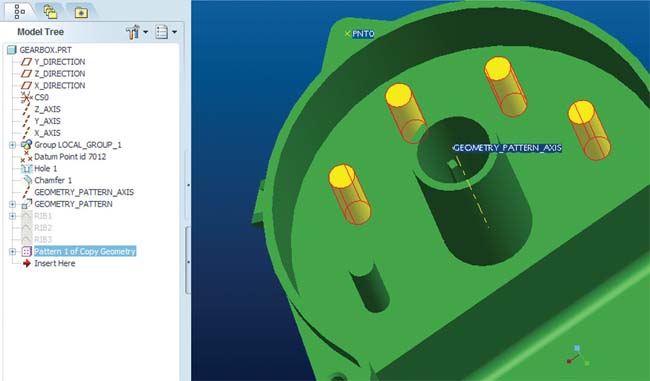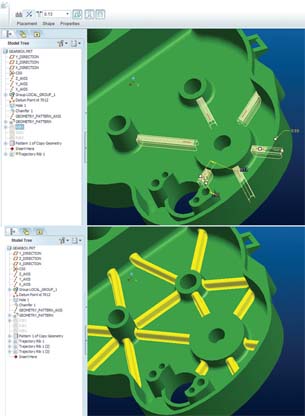March 1, 2010
By Kenneth Wong
Pro/ENGINEER Wildfire 5.0, the latest version of PTC’s flagship MCAD package, hits the market nearly two years after PTC acquired CoCreate, a direct-modeling software company. Though Pro/E remains a parametric modeler, the software makes parametric editing easier and faster by adopting push-pull modeling methods commonly found in direct modelers. Sophisticated patterning, mirroring, tab-creation, and rib-creation tools speed up modeling tasks for shelled plastic and sheet metal. Also returning in this release is the digital manikin, first introduced in November 2008 as part of release 4.0. The 3D human figure is designed to give you a way to study and visualize your machines and assemblies in proportion to an average person’s physique.
 Using an axis as center, you can pattern a feature along an arc segment. |
For Newcomers
If you’re unfamiliar with Pro/E, here are a few tips that might speed up your initiation process. Pro/E makes use of the middle-mouse wheel (MMW) quite extensively. Whereas using the MMW for zooming in and out may be intuitive for most, other uses might not be quite so apparent. For instance, to pan the model, you hold the Shift key and the MMW simultaneously, then drag the model around. Similarly, to rotate a model, you keep the MMW pressed down as you drag the mouse around. In addition, you may also use the MMW in the Sketcher (2D sketching mode) to complete an operation, say, finishing a circle or a rectangle, or to cancel out something in mid-operation, like an erroneous line segment.
If you’re performing a parametric operation, like rounding an edge, you can turn to the text prompts and suggestions that appear right below the main menus. It’s also the same place where you’ll be prompted to enter numeric values and edge selections, such as the number of times you want to repeat a feature or the edge along which you want to pattern a feature. If you’re unable to decipher the purpose of a menu button, hover your mouse over it briefly. A text explanation will appear.
 Trajectory ribs can be copied and pasted into new locations. |
I tend to set my display screen’s background color to a much darker shade than the default (the soothing shade of blue is easy on the eye but I find that it sometimes obscures lines and edges). I prefer a sharp contrast that makes it easy for me to spot the irregular lines and edges. If you feel similarly, to customize your system color scheme, go to View > Display Settings > System Colors, then change the color scheme in the dialog box to suit yourself.
Pushing Pixels
This release marks the debut of Dynamic Edit, which lets you make parametric edits by pushing, pulling, and dragging on surfaces and edges. (If you’re a SolidWorks user, you’ll recognize its similarity to SolidWorks Instant 3D.) In this mode, you see the results of your edits in real time, because geometry regeneration is instantaneous. That means you can adjust the depth of an extrusion, the radius of a rounded edge, or the diameter of a hole by directly interacting with the feature. In fact, you can grab an entire feature, such as an extruded profile, then move it along a surface to a new location.
To activate this, you can select a parametric feature from the model tree, then right-click, and select Dynamic Edit. This gives you little drag handles you can use to control and adjust the feature. You can still click on the numeric value that appears right alongside the drag handle, and then enter a new value to adjust the feature. But if you’re in conceptual design phase, you may find that the drag handles give you more freedom to explore shape possibilities and push aesthetic boundaries.
Bear in mind, however, that Pro/E still remains a parametric modeler—that is, a program that models 3D geometry according to the history of your parametric steps. Though Dynamic Edit lets you interactively edit your model the way you might do it in direct modelers like CoCreate, Autodesk Inventor Fusion, or SpaceClaim, you’re essentially making parametric edits, not direct edits. That becomes evident if you inspect the model tree in Pro/E. You’ll find that the tree is made up of a hierarchy of parametric features, not a series of solids and surfaces (which would be the case with models created in direct modelers).
Complex Patterning
Aside from simple patterning operations (like repeating an extruded feature along a straight line, spaced apart by a certain distance), you can also perform certain complex patterning operations. For example, you may select a feature, then pattern it along an imaginary arc segment, using a predefined axis as center. Using the patterning command, you can also duplicate a feature onto a surface, using a datum point to anchor the new feature with precision.
In plastic parts and shell parts with many internal structures, the Trajectory Ribs command can come in handy. Essentially, it lets you automatically create ribs that extend into various directions, terminating when they come in contact with nearby solids and surfaces. Once you have created a rib cluster, you can duplicate the same structure at another location by copying and pasting it. To do this, you select the trajectory ribs as a group, go to Edit > Copy, then Edit > Paste, and select the target rib base in the model tree.
The Manikin (Nicknamed Bob)
This release marks the return of the digital manikin, which I took the liberty of renaming Bob. (Bob has a female counterpart, so you may also call yours Jane.) You can drop Bob into an assembly environment by going to Insert > Manikin (just make sure you have a flat surface for him to stand on). For those who routinely work with heavy machinery and plant assemblies, Bob offers an easy way to study clearances, ergonomics, and line of sight. Because Bob comes with various factory-oriented poses (for example, kneeling, pushing, bending down, or with arms stretched), you can check to see if certain dials and levers are too high or too low for him to reach.
Depending on the region your design is destined for, you might need to adjust Bob’s parameters to correspond to the physique of the average local worker. To do that, you right-click, then choose Edit Parameters. For more advanced design and analysis capabilities, you can upgrade to the Pro/E Manikin Extension license to operate it fully.
Installation
The license activation process, in my view, is more complex than it should be, perhaps to discourage unauthorized use. The license keys came as two .txt attachments in an e-mail: one for node-locked license (which, I discovered, means to install the software on a single machine, identified via CPU ID); another for license borrowing. The instruction reads:
Save the attachment as a .txt file on the license server.
Import this license file into PTC.Setup (using ptcsetup.bat).
The strings __HOSTNAME__ and __PTCD_PATH in the SERVER and DAEMON lines are automatically replaced with the hostname of the license server and the path to the ptc_d executable located in the FLEXLM directory, respectively. For example: SERVER spock PTC_HOSTID = 11-22-33-44-55-66 7788 DAEMON ptc_d d:ptcflexlmi486_ntobjptc_d.
Unable to make heads or tails of this, I resorted to contacting Tech Support, which proved incredibly helpful and responsive. I managed to install the software by granting the technician permission to take control of my desktop. Essentially, he finished it on my behalf.
A Dynamic Return
Aside from the hiccup in license activation, I find Pro/E Wildfire 5.0 to be highly interactive and responsive. Rightly or wrongly, people associate push-pull modeling with ease of use; therefore, the addition of Dynamic Edit makes PTC’s parametric heavyweight less intimidating, especially for newcomers encountering it for the first time. With the digital manikin, Pro/E reminds us of a critical consideration that’s often overlooked in design: the human factor.
For a video preview of Wildfire 5.0, visit /de/virtual-desktop-mcad-news-video-edition-january-14-2010.
More Info:
PTC
Kenneth Wong writes about technology, its innovative use, and its implications. One of DE’s MCAD/PLM experts, he has written for numerous technology magazines and writes DE’s Virtual Desktop blog at deskeng.com/virtual_desktop/. You can follow him on Twitter at KennethWongCAD, or send e-mail to [email protected].
Subscribe to our FREE magazine, FREE email newsletters or both!
About the Author
Kenneth Wong is Digital Engineering’s resident blogger and senior editor. Email him at [email protected] or share your thoughts on this article at digitaleng.news/facebook.
Follow DE





